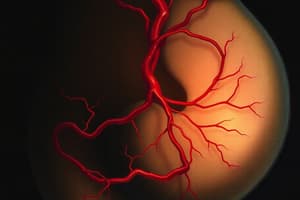Podcast
Questions and Answers
What structural change occurs to the umbilical arteries after birth?
What structural change occurs to the umbilical arteries after birth?
- They develop into the superior vesicular arteries.
- They remain functional for blood circulation.
- They transform into medial umbilical ligaments. (correct)
- They become part of the aorta.
What happens to the foramen ovale after birth?
What happens to the foramen ovale after birth?
- It remains open for blood flow.
- It turns into the ligamentum venosum.
- It connects the pulmonary artery to the aorta.
- It closes and forms the fossa ovalis. (correct)
Which of the following describes the functional difference in blood flow from fetus to infant?
Which of the following describes the functional difference in blood flow from fetus to infant?
- Blood flow shifts from right to left shunting.
- Blood flow transitions from systemic to pulmonary.
- Blood flow remains unchanged in both systems.
- Blood flow changes from low to high pressure system. (correct)
What is the outcome of the ductus arteriosus after birth?
What is the outcome of the ductus arteriosus after birth?
What role does the umbilical vein play after atrophy?
What role does the umbilical vein play after atrophy?
What is the primary role of the umbilical vein in fetal circulation?
What is the primary role of the umbilical vein in fetal circulation?
How does blood bypass non-functioning lungs in fetal circulation?
How does blood bypass non-functioning lungs in fetal circulation?
Which statement accurately describes the ductus arteriosus?
Which statement accurately describes the ductus arteriosus?
What happens to the blood that flows from the right atrium in a fetus?
What happens to the blood that flows from the right atrium in a fetus?
During fetal circulation, which structures help to return non-oxygenated blood to the placenta?
During fetal circulation, which structures help to return non-oxygenated blood to the placenta?
Where does oxygenated blood flow immediately after reaching the fetus through the umbilical vein?
Where does oxygenated blood flow immediately after reaching the fetus through the umbilical vein?
What anatomical structure receives a small amount of blood routed from the ductus venosus?
What anatomical structure receives a small amount of blood routed from the ductus venosus?
What is one consequence of increased blood flow to the liver in newborns?
What is one consequence of increased blood flow to the liver in newborns?
What role do the umbilical arteries play in fetal circulation?
What role do the umbilical arteries play in fetal circulation?
What is the main reason the foramen ovale closes after birth?
What is the main reason the foramen ovale closes after birth?
What physiological change occurs to the lungs at birth?
What physiological change occurs to the lungs at birth?
What happens to blood flow in the fetal heart?
What happens to blood flow in the fetal heart?
What significant pressure change occurs when the umbilical cord is clamped at birth?
What significant pressure change occurs when the umbilical cord is clamped at birth?
What is the result of the closure of the foramen ovale?
What is the result of the closure of the foramen ovale?
What is a patent foramen ovale?
What is a patent foramen ovale?
How is blood oxygenated in fetal circulation?
How is blood oxygenated in fetal circulation?
What causes the closure of the ductus arteriosus after birth?
What causes the closure of the ductus arteriosus after birth?
What happens to blood flow after the foramen ovale closes?
What happens to blood flow after the foramen ovale closes?
What physical change contributes to the functional closure of the ductus venosus?
What physical change contributes to the functional closure of the ductus venosus?
What condition results if the ductus venosus fails to close after birth?
What condition results if the ductus venosus fails to close after birth?
What causes the decrease in pressure in the right atrium after birth?
What causes the decrease in pressure in the right atrium after birth?
Which of the following events does NOT contribute to the closure of the foramen ovale?
Which of the following events does NOT contribute to the closure of the foramen ovale?
What anatomical connection does the ductus arteriosus primarily serve?
What anatomical connection does the ductus arteriosus primarily serve?
What factors induce the constriction of the ductus arteriosus at birth?
What factors induce the constriction of the ductus arteriosus at birth?
Flashcards
Ligamentum Teres Hepatis
Ligamentum Teres Hepatis
The umbilical vein, a part of the fetal circulation, shrinks and becomes a ligament in the liver after birth.
Ligamentum Venosum
Ligamentum Venosum
The ductus venosus, a fetal blood vessel that connects the umbilical vein to the inferior vena cava, turns into a ligament after birth.
Fossa Ovalis
Fossa Ovalis
The foramen ovale, an opening in the heart that allows blood to bypass the lungs in the fetus, closes after birth, leaving a depression called fossa ovalis.
Ligamentum Arteriosum
Ligamentum Arteriosum
Signup and view all the flashcards
Medial Umbilical ligaments
Medial Umbilical ligaments
Signup and view all the flashcards
Umbilical vein role
Umbilical vein role
Signup and view all the flashcards
Ductus Venosus
Ductus Venosus
Signup and view all the flashcards
Foramen Ovale
Foramen Ovale
Signup and view all the flashcards
Ductus Arteriosus
Ductus Arteriosus
Signup and view all the flashcards
Umbilical arteries role
Umbilical arteries role
Signup and view all the flashcards
Placenta Function
Placenta Function
Signup and view all the flashcards
Fetal Circulation Overview
Fetal Circulation Overview
Signup and view all the flashcards
Fetal to Infant Circulation
Fetal to Infant Circulation
Signup and view all the flashcards
Umbilical Arteries
Umbilical Arteries
Signup and view all the flashcards
Placenta
Placenta
Signup and view all the flashcards
Fetal Circulation: Low Pressure
Fetal Circulation: Low Pressure
Signup and view all the flashcards
Umbilical Cord Clamping
Umbilical Cord Clamping
Signup and view all the flashcards
Lung Expansion and Blood Flow
Lung Expansion and Blood Flow
Signup and view all the flashcards
Closure of Foramen Ovale
Closure of Foramen Ovale
Signup and view all the flashcards
Pulmonary Arteries
Pulmonary Arteries
Signup and view all the flashcards
Closure of the foramen ovale
Closure of the foramen ovale
Signup and view all the flashcards
Closure of the ductus arteriosus
Closure of the ductus arteriosus
Signup and view all the flashcards
Patent ductus arteriosios
Patent ductus arteriosios
Signup and view all the flashcards
Closure of the ductus venosus
Closure of the ductus venosus
Signup and view all the flashcards
Portosystemic shunt
Portosystemic shunt
Signup and view all the flashcards
Increased systemic vascular resistance after birth
Increased systemic vascular resistance after birth
Signup and view all the flashcards
Change from right to left shunting to left to right blood flow after birth
Change from right to left shunting to left to right blood flow after birth
Signup and view all the flashcards
Pressure change in the right atrium after birth
Pressure change in the right atrium after birth
Signup and view all the flashcards
Study Notes
Fetal Circulation and Changes at Birth
- Fetal circulation differs significantly from infant circulation. The fetus relies on the placenta for oxygen and nutrient delivery.
- The umbilical vein carries oxygenated blood from the placenta to the fetus.
- After entering the fetus, the blood flows through the inferior vena cava.
- Two umbilical arteries carry deoxygenated blood and waste products back to the placenta.
- Specialized structures facilitate fetal circulation:
- Ductus venosus: carries blood from the umbilical vein to the inferior vena cava, bypassing the liver.
- Foramen ovale: a hole in the heart that allows blood to flow directly from the right atrium to the left atrium, bypassing the lungs.
- Ductus arteriosus: shunts blood from the pulmonary artery to the aorta, bypassing the lungs.
- Most of the oxygenated blood bypasses the lungs.
- After birth, several crucial changes occur:
- Clamping the umbilical cord alters blood flow patterns.
- Increased atmospheric pressure and systemic vascular resistance lead to lung inflation and higher blood pressure in the left side of the heart, causing the following:
- Closure of the foramen ovale.
- Closure of the ductus arteriosus.
- Closure of the ductus venosus.
- The lungs become functional. Blood flow changes from lung bypass to the lungs.
- Umbilical arteries and vein atrophy and become ligaments (ligamentum arteriosum, ligamentum venosum, and ligamentum teres).
- The change in pressure results in the closure of the foramen ovale.
- The changes in pressure and oxygen levels result in the closure of the ductus arteriosus.
- The structure of the fetal circulatory system transforms into that of an infant.
Objectives
- Discuss the anatomy and physiology of fetal circulation, including the fetal circulatory system's special structures.
- Compare and contrast fetal circulation to infant circulation.
- Define specialized structures of fetal circulation in detail, explaining their roles.
Studying That Suits You
Use AI to generate personalized quizzes and flashcards to suit your learning preferences.




